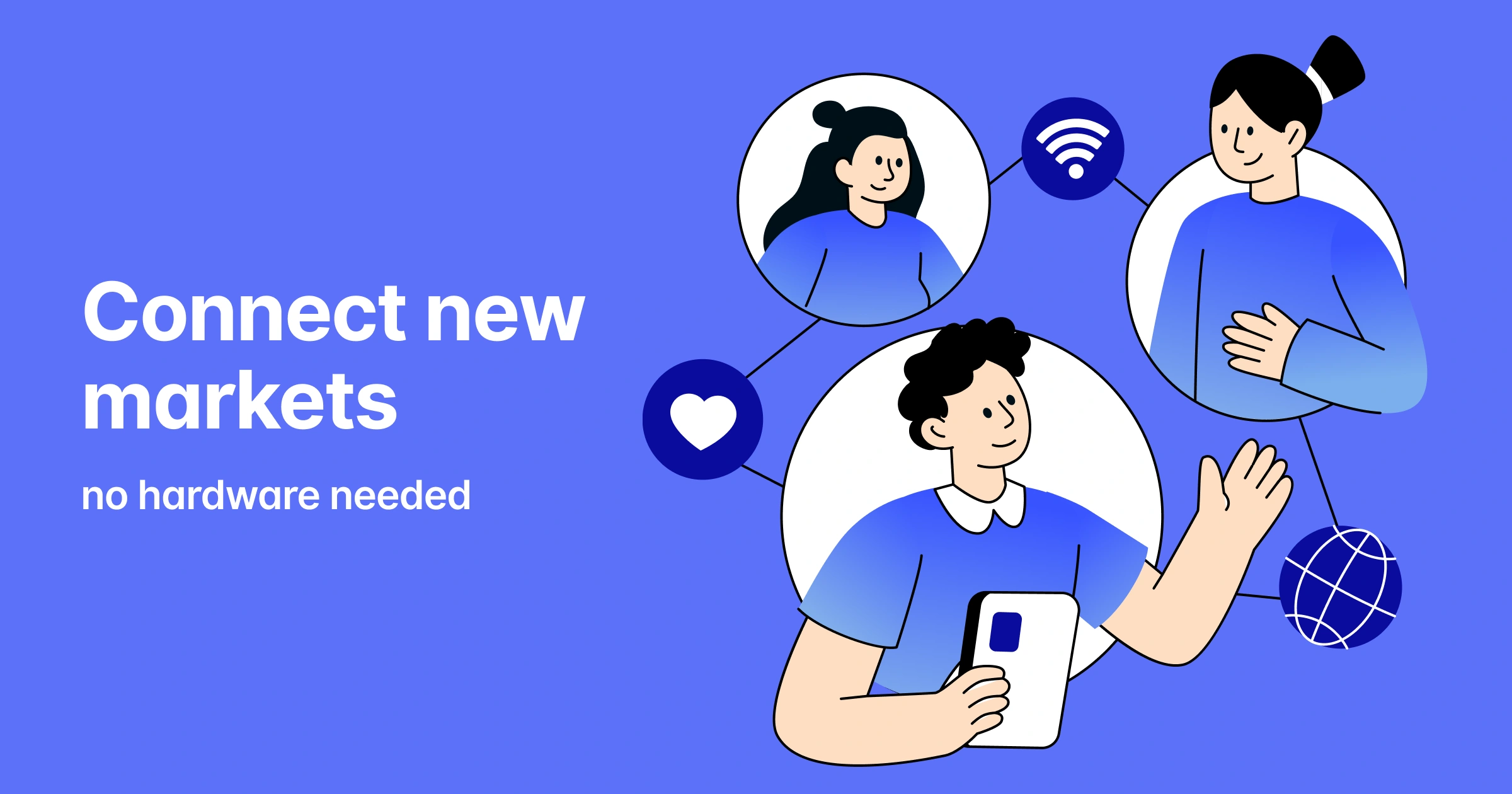

Oleh Romaniuk
September 30, 2025
Scaling Without Borders: How to Connect New Countries Without Purchasing Hardware
It’s the strangest thing: the 21st century has people worldwide more connected than ever, yet when it comes to extending a business communication abroad, it’s suddenly tangled and complex all over again.
The good news is that it doesn’t have to be; the better news is that the ease of communication is completely real, even without hiring an additional IT department. You have to neither pay for a myriad of foreign numbers that eat up budget like a moth eats a fur coat, nor manage their endless list, as well as dive into the complexities of the hosted or even on-premise PBX. International calls with VoIP is what comes to the rescue.
A significant percentage of businesses have already adopted this technology. A Frost & Sullivan survey indicates that 96% of North American enterprises will have a cloud or mobile PBX base, with many transitioning to a fully cloud-based system, which is why, in this article, we’re going to dive into how it works, what it saves up for your team and budget, and whether or not there are hidden nuances.
What is VoIP and how does it work?
At its core, Voice over Internet Protocol – or VoIP – is simply a smarter way to handle calls. Instead of relying on copper lines or heavy hardware, your voice turns into digital packets and travels over the internet, reaching the other side in milliseconds. This shift removes the need for a local switchboard or physical PBX and instead gives you a simple business phone system that lives in the cloud.
When you dial a number, VoIP routes your call through secure internet channels, connects it with the recipient’s device, and delivers clear audio without you ever noticing the difference. The best part is that the same setup can carry thousands of calls at once, making it a reliable, scalable, and interoperable internet telephony option for companies of any size.
On-Premise vs Hybrid vs Cloud PBX
To understand the real value of VoIP, it helps to look at where most businesses come from. An on-premise PBX is the old-school setup: a bulky box in the office that you buy, maintain, and troubleshoot yourself. It gives you control, but it’s expensive to scale and a headache to upgrade.
A hybrid PBX is the halfway point. Some call routing and storage stay on-site, while extra features – like international numbers or call failover – live in the cloud. This works for companies that want to keep legacy equipment running but need modern flexibility.
Finally, there’s the cloud or virtual PBX, where everything sits on your provider’s infrastructure. You don’t buy new gear or keep servers humming – you just log in, connect your devices, and start calling. For businesses aiming at VoIP expansion into new countries, this model offers the fastest rollout, the lowest upfront cost, and the easiest way to scale without borders.
Essential and Optional VoIP Equipment
Switching to VoIP isn’t about stacking servers in a back room – it’s about keeping things lean. Still, there are a few basics every business needs, plus optional tools that can fine-tune the setup depending on how big your team is and how you plan to grow.
Essential equipment
-
Reliable internet connection – VoIP calls run on bandwidth, not copper lines. A stable, high-speed connection with enough upload and download capacity is non-negotiable. For smooth calls, plan on at least 100 kbps per line. With VoIP no hardware PC setups, even a standard laptop with a headset is enough to get started.
-
Devices to make calls – Laptops, smartphones, or tablets are enough to get started. Most providers (including Teliqon) let you run a simple virtual business phone through a softphone app or browser without installing extra gear.
-
Headsets or built-in mics – Audio quality is key. Even basic USB or Bluetooth headsets reduce echo and background noise compared to built-in laptop mics.
-
Router/firewall – Your existing office router works, but ensure it can prioritize voice traffic (QoS). This keeps conversations clear even when other devices are eating up bandwidth.
Optional equipment
-
IP desk phones – Useful if your team is used to a traditional handset. They connect directly to the internet, no PBX needed, and provide the tactile feel some roles still prefer.
-
Session Border Controllers (SBCs) – For IT teams managing sensitive data, SBCs add an extra security layer, encrypting and controlling VoIP sessions. Not required for most SMBs, but valuable for enterprises.
-
Dedicated VoIP routers – In larger offices, these help prioritize voice packets and prevent jitter when traffic spikes.
-
Conference phones and video gear – Sales, HR, or leadership teams might want dedicated devices for boardroom-style meetings.
-
Analytics dashboards and call center software – These ride on top of your VoIP setup, giving visibility into call quality, agent performance, and customer experience. Perfect if you’re preparing for VoIP scalability across multiple teams or countries.
The bottom line: to get started, you really just need internet, a device, and a way to listen and speak. Everything else is optional – scaling equipment comes into play only if you want more control, security, or enterprise-grade comfort.
Why built-in analytics and call tools matter
Having VoIP is only half the story; knowing how your calls perform is what actually drives growth. With real-time dashboards, managers see answer rates, wait times, or peak hours instantly instead of guessing. Integrated call center tools help agents work smarter – routing customers to the right person, recording conversations for training, or spotting trends before they turn into problems.
For a sales team, that means spotting which campaigns bring the most leads. For support, it means fewer missed calls and faster resolution. For leadership, it’s visibility across the whole communication flow without patching together third-party apps. In other words, built-in tools make a simple telephony setup not just functional, but powerful.
On the Teliqon platform, these capabilities come standard. The Call Analytics gives a real-time view into answer rates, call duration, and abandoned calls, while features like smart routing, call queues, and IVR to keep service seamless even at peak times. Together, they help teams turn everyday call data into decisions that save time, cut costs, and keep customers happier.
What VoIP really saves and how to get the best of it
The clearest win with VoIP is cost. By skipping hardware, international lines, and per-minute fees from legacy providers, companies see their bills shrink fast. A simple business phone system in the cloud also scales without new contracts – adding users or new countries is a matter of clicks, not technicians. For global teams, that’s time and budget redirected straight into growth.
But savings go beyond the monthly invoice. Less downtime, better call routing, and built-in analytics mean teams waste fewer hours on missed calls or troubleshooting. Productivity gains add up, especially when customer support or sales handle high volumes.
What to pay attention to?
Of course, there are nuances. Call quality still depends on your internet connection – skimping on bandwidth can undo the benefits. Security matters too, which is why leading providers layer in encryption and monitoring by default. And while setup is simple, onboarding your team to new tools always deserves planning. With the right provider, these are manageable details rather than deal-breakers.
In short, VoIP offers the chance to enjoy global VoIP communications without the drag of heavy infrastructure – as long as businesses treat it as a system, not just a cheap dial tone.
“Expanding into new markets shouldn’t feel like building phone rooms in every city – VoIP removes that barrier. With a browser, a stable internet connection, and virtual numbers, companies can look local while staying global. The real breakthrough is combining simplicity with scale – growing across borders without hardware or IT headaches.”

Oleh Romaniuk
Co-Founder at Teliqon
Final word
Global growth shouldn’t mean wiring new offices or wrestling with legacy phone systems. VoIP for international calls makes global communication straightforward, affordable, and scalable – and it means your business has the freedom to focus on customers instead of infrastructure.
Let Teliqon help you reach this goal as a reliable communication solutions provider. With virtual numbers available in more than 170 countries – local, toll-free, or mobile – you can establish presence anywhere your customers are without opening a physical office or juggling multiple vendors. Pair that with our Cloud PBX and built-in call analytics, and you get a communication setup that scales as easily as your business does.
Ready to make international calling as simple as local? Start with Teliqon and see how scaling without borders really works – no hardware required.
The latest from Teliqon
Stay ahead with insights from the leader in trusted communications. Subscribe for the latest blogs, updates, and exclusive content.




